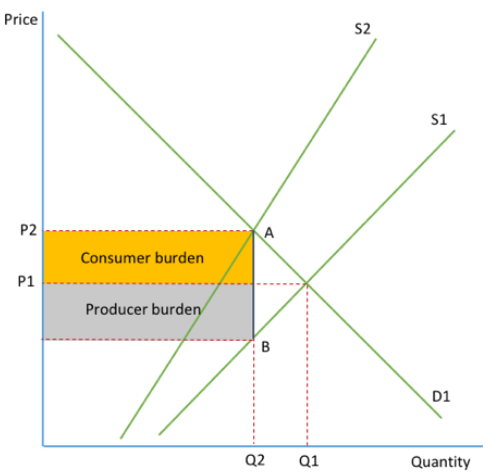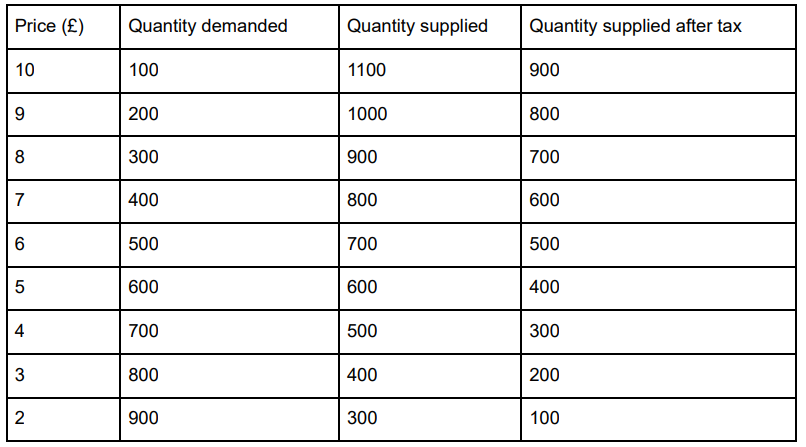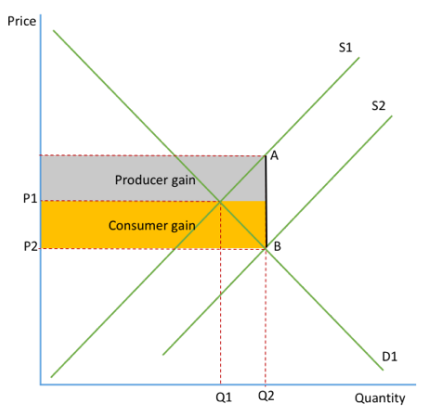1.2.9 Indirect taxes and subsidies
1/8
There's no tags or description
Looks like no tags are added yet.
Name | Mastery | Learn | Test | Matching | Spaced |
|---|
No study sessions yet.
9 Terms
INDIRECT TAXES
a tax on expenditure where the person who is ultimately charged the tax is not the person responsible for paying the sum to the government
The business is required to pay the tax but the consumer is charged instead
2 TYPES: ad valorem and specific tax
AD VALOREM TAX
where the tax payable increases in proportion to the value of the good
The tax is a % of the cost of the good- E.G. VAT
SPECIFIC TAX
a set amount per unit of the product sold
The tax increases with the amount bought rather than the value of goods
For example, excise duties on alcohol, tobacco and petrol are a specific amount
SPECIFIC TAX- DIAGRAM
The introduction of the tax causes supply to shift from S1 to S2 because it leads to an increase in the cost of production
This leads to a rise in price from P1 to P2 and a fall in output from Q1 to Q2
The consumer sees higher prices and suffers from a tax burden of the orange area
The producer sees a rise in costs and a fall in output, suffering from the tax burden of the grey area
The government gains tax revenue of the shaded areas (ABxQ2)
The size of the tax is the vertical distance between S1 and S2, shown by the line AB.

AD VALOREM TAX- DIAGRAM
The effects are the same but the supply curve shifts and tilts, so that the gap between S1 and S2 grows
This is because the tax is a % of the value
When price is small, tax will only be a small amount but when price is high, tax will be a large amount
The vertical distance between the curve represents size of tax, and so distance grows as tax grows.

TAX EFFECT E.G.
This table shows the effect of a £2 tax being imposed
The initial equilibrium price was £5
With the new tax, when the business charges £5 for their product they only get £3 as £2 is passed onto the gov-so, if they are charging £5 with the tax, they are only willing to supply the same if the price was £3 without the tax
Quantity supplied shifts, and the equilibrium price is now £6 where quantity demanded is equal to quantity supplied after tax
means that the incidence on the consumer is only £1 of the tax and the supplier is also only paying £1

INCIDENCE OF TAX
the tax burden on the taxpayer
If the demand curve (PED) is perfectly elastic, or the supply curve (PES) is perfectly inelastic, the supplier will pay all the tax
If the demand curve is perfectly inelastic, or the supply curve is perfectly elastic, all the tax will be passed on to the consumer
the more elastic the demand curve, or the more inelastic the supply curve, the lower the incidence of tax on the consumer, meaning the supplier has to pay more
means that, ceteris paribus, the more inelastic the demand curve, the higher the revenue of tax for the gov because quantity demanded falls less and the more goods that are bought
SUBSIDY
a grant given by the government- an extra payment to encourage production/consumption of a good or service
They could be given to necessities
SUBSIDY- DIAGRAM
diagram shows an increase in supply from S1 to S2, since the producer sees a fall in production costs due to the subsidy
As a result, there is a rise in output from Q1 to Q2 and a
fall in price from P1 to P2
consumer subsidy is the orange box and producer subsidy is the grey box
The total shaded area represents government spending: equal to the size of the subsidy (AB) times the new output (Q2).
